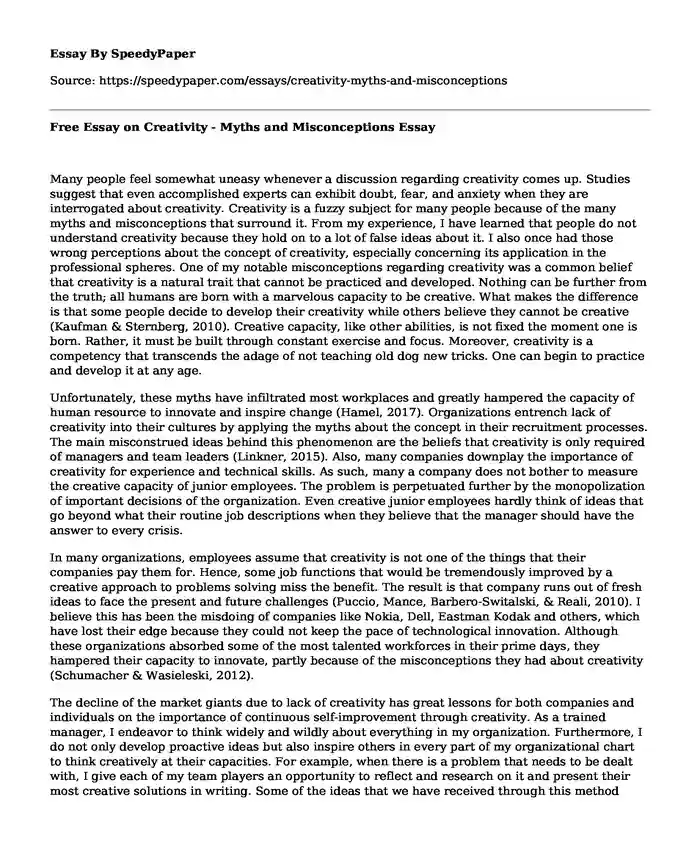
| Type of paper: | Article |
| Categories: | Human resources Development |
| Pages: | 3 |
| Wordcount: | 689 words |
Many people feel somewhat uneasy whenever a discussion regarding creativity comes up. Studies suggest that even accomplished experts can exhibit doubt, fear, and anxiety when they are interrogated about creativity. Creativity is a fuzzy subject for many people because of the many myths and misconceptions that surround it. From my experience, I have learned that people do not understand creativity because they hold on to a lot of false ideas about it. I also once had those wrong perceptions about the concept of creativity, especially concerning its application in the professional spheres. One of my notable misconceptions regarding creativity was a common belief that creativity is a natural trait that cannot be practiced and developed. Nothing can be further from the truth; all humans are born with a marvelous capacity to be creative. What makes the difference is that some people decide to develop their creativity while others believe they cannot be creative (Kaufman & Sternberg, 2010). Creative capacity, like other abilities, is not fixed the moment one is born. Rather, it must be built through constant exercise and focus. Moreover, creativity is a competency that transcends the adage of not teaching old dog new tricks. One can begin to practice and develop it at any age.
Unfortunately, these myths have infiltrated most workplaces and greatly hampered the capacity of human resource to innovate and inspire change (Hamel, 2017). Organizations entrench lack of creativity into their cultures by applying the myths about the concept in their recruitment processes. The main misconstrued ideas behind this phenomenon are the beliefs that creativity is only required of managers and team leaders (Linkner, 2015). Also, many companies downplay the importance of creativity for experience and technical skills. As such, many a company does not bother to measure the creative capacity of junior employees. The problem is perpetuated further by the monopolization of important decisions of the organization. Even creative junior employees hardly think of ideas that go beyond what their routine job descriptions when they believe that the manager should have the answer to every crisis.
In many organizations, employees assume that creativity is not one of the things that their companies pay them for. Hence, some job functions that would be tremendously improved by a creative approach to problems solving miss the benefit. The result is that company runs out of fresh ideas to face the present and future challenges (Puccio, Mance, Barbero-Switalski, & Reali, 2010). I believe this has been the misdoing of companies like Nokia, Dell, Eastman Kodak and others, which have lost their edge because they could not keep the pace of technological innovation. Although these organizations absorbed some of the most talented workforces in their prime days, they hampered their capacity to innovate, partly because of the misconceptions they had about creativity (Schumacher & Wasieleski, 2012).
The decline of the market giants due to lack of creativity has great lessons for both companies and individuals on the importance of continuous self-improvement through creativity. As a trained manager, I endeavor to think widely and wildly about everything in my organization. Furthermore, I do not only develop proactive ideas but also inspire others in every part of my organizational chart to think creatively at their capacities. For example, when there is a problem that needs to be dealt with, I give each of my team players an opportunity to reflect and research on it and present their most creative solutions in writing. Some of the ideas that we have received through this method have opened our eyes to new, unprecedented opportunities.
References
Hamel, G. (2017). Moon Shots for Management. Harvard Business review.Kaufman, J. C., & Sternberg, R. J. (2010). The Cambridge handbook of creativity. New York: Cambridge University Press.
Linkner, J. (2015, October 19). 5 Common Myths About Creativity. Retrieved from https://www.forbes.com/sites/joshlinkner/2015/10/19/the-5-myths-of-creativity/2/#44aafea65e34
Puccio, G. J., Mance, N., Barbero-Switalski, L., & Reali, D. (n.d.). Creativity Rising: Creative Thinking and Creative Problem Solving in the 21st Century. NY: CSC.
Schumacher, E. G., & Wasieleski, D. M. (2012). Institutionalizing Ethical Innovation in Organizations: An Integrated Causal Model of Moral Innovation Decision Processes. Journal of Business Ethics, 113(1), 15-37. doi:10.1007/s10551-012-1277-7
Cite this page
Free Essay on Creativity - Myths and Misconceptions. (2022, Apr 05). Retrieved from https://speedypaper.net/essays/creativity-myths-and-misconceptions
Request Removal
If you are the original author of this essay and no longer wish to have it published on the SpeedyPaper website, please click below to request its removal:
- Financial Field Essay Example
- Vigilantism Research, Essay Example
- Essay Example on the Accuracy of Assessment Tests
- Essay Sample about the World City Hypothesis
- Free Essay with the Summary of Jensen's Speech to Howard Beale on "Forces of Nature"
- Essay Sample: The History of Immigration in the United States
- Free Essay Sample on Improving Interpersonal Communication
Popular categories




